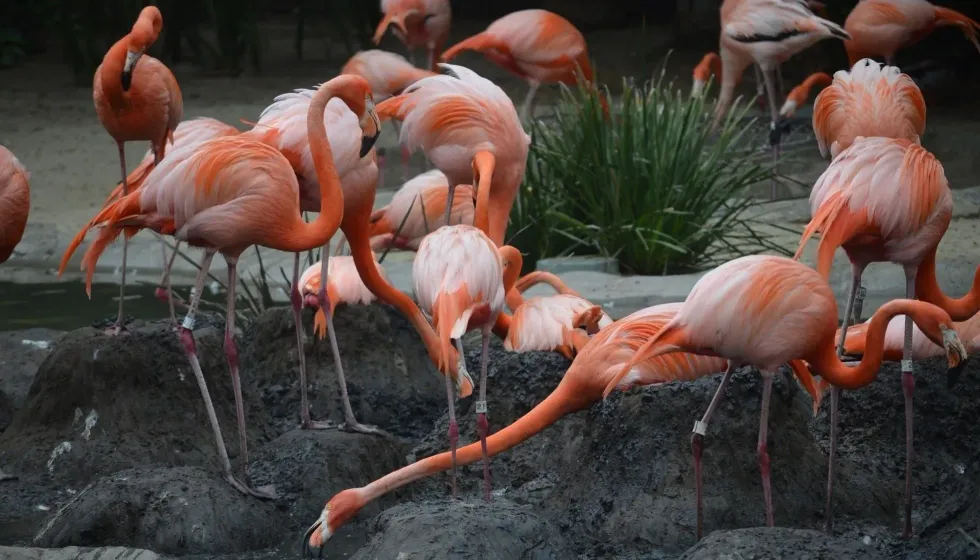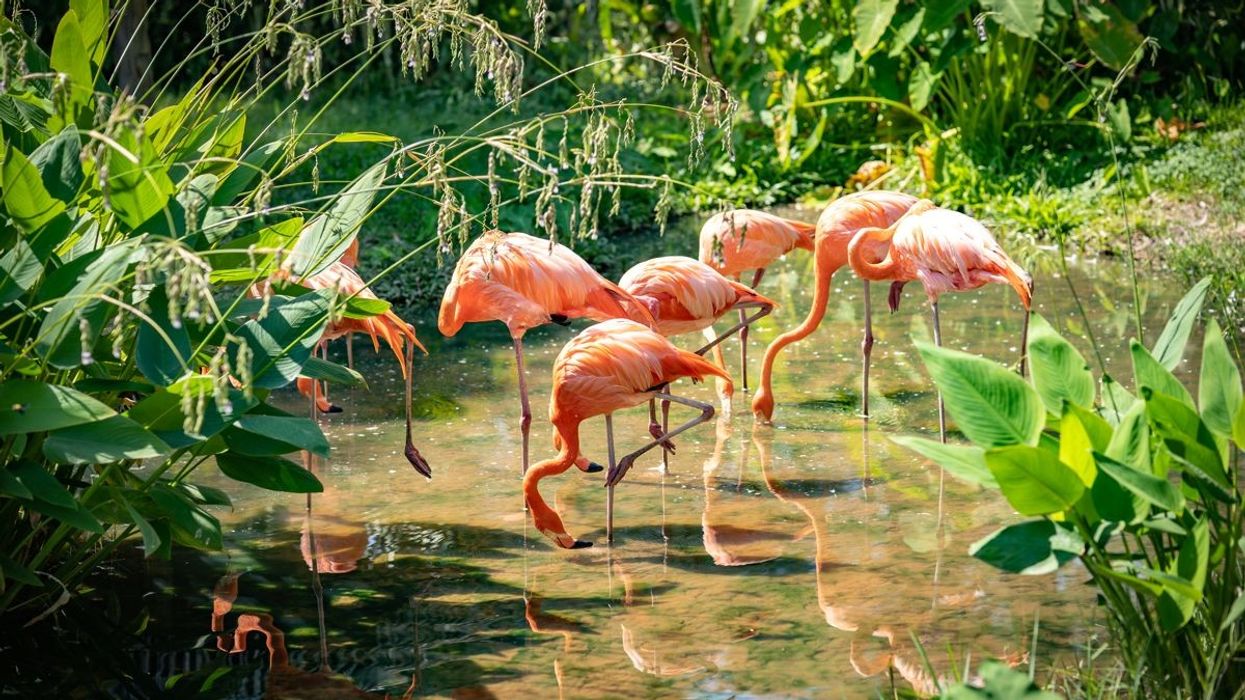With long legs and pink feathers, American flamingos are a tourist favorite. The American flamingo (Phoenicopterus ruber) is known for its osmoregulation qualities. Being near salty water, their diet (fish and invertebrates) contains high salt levels. Their kidneys can filter out the salt, causing flamingoes to survive even after eating high-sodium content food.
Similarly, they can drink water from natural geysers that are almost at boiling temperature! Their bill possesses a salt gland that filters out the excess salt.
They are wading birds and use their long legs to feed on fish while walking in quite deep water. The American flamingo (Phoenicopterus ruber) is also known as the Caribbean flamingo. They are migratory birds and are seen to change locations depending on the season.
If this interests you, be sure to check out the greater flamingo and the flamingo too!
American Flamingo Interesting Facts
What type of animal is an American flamingo?
The American flamingo is a type of bird.
What class of animal does an American flamingo belong to?
The American flamingo belongs to the class of Aves. It is the only bird in the Phoenicopteridae family and contains six separate flamingo species.
How many American flamingos are there in the world?
There is currently an estimated number of 260,000-330,000 flamingos in the world. The current population trend of this species is increasing.
Where does an American flamingo live?
The species of American or Caribbean flamingoes are found in a number of places like North America and the Caribbean islands. This includes the Bahamas, Cuba, some parts of Canada, Puerto Rico, the Cayman Islands, Brazil, and Colombia.
What is an American flamingo's habitat?
This species of birds are generally found along with saline waterbeds like mudflats, brackish lagoons and lakes, and estuaries as they feed on fishes and algae. They prefer shallow water they can wade in with their long body.
They also nest on the sandy flats. Some species are also found in inland lakes as long as these have saline waters. Due to the rise in water levels, the American flamingo habitat is slowly disappearing and their eggs (laid on the ground) are sometimes washed away.
Who do American flamingos live with?
American flamingos are seen to live together in a large numbers with flocks of around thousands of birds. These flocks contain both male and female birds. The flock spends their entire day looking for food. Once an area has exhausted its supply, the flock looks for a new place.
How long does an American flamingo live?
The average lifespan for this species of flamingo is around 30-40 years in the wild. However, when kept in captivity, the flamingos may live for as long as 50-60 years!
How do they reproduce?
American flamingos are monogamous so breeding occurs between only one pair during the breeding season. American flamingos have an interesting mating behavior where the male of the species tries to impress the female.
The female controls the process and may choose a certain male. After an extensive dancing ritual, the two then select a nesting site if the female allows it. The breeding pair often sleeps and eats together.
The mating occurs within the colony itself. A variety of bonded pair behavior is seen, such as one male bird with two female birds or vice versa.
Here, one female bird is dominant whereas the other assumes a subservient role. Both flamingos are hands-on parents and build the nest together, or the dominant one may lead the process. The female lays one single egg after mating.
If there are two females in the group, then they may try to roll each other's eggs out of the nest. Both parents incubate the egg alternatively.
Once the young chick hatches, the feeding begins. The chick has gray feathers, shorter legs and feet, and white, straight beaks.
The parents take care of the young one for 70-75 days. The number can be as high as 105 days for some chicks. The babies feed on crop milk, regurgitated by their parents.
After this, the chicks may venture out of the nest. Chicks may require up to two years to become full-fledged adults and fend for themselves.
What is their conservation status?
The IUCN classifies the north American flamingo as an animal of Least Concern. However, some other species like the Chilean flamingo are not so huge in numbers. In the US, the birds and their habitat are protected under the U.S. Migratory Bird Act. A flamingo's flock serves as its own protection against predators.
American Flamingo Fun Facts
What do American flamingos look like?

American flamingos are very distinctive birds with their tall body and slender, small head, long legs, and curved bill. Their feathers are bright pink, with a lighter underbelly and black towards the edges of their flying feathers. They have webbed feet, which helps them to wade in the mud.
The flamingos have undergone various body adaptations to suit their environment. Their head and long neck allow them to search for food through shallow waters freely. Adult flamingos sometimes sleep with one of their feet up to save body heat.
How cute are they?
The flamingos of North America are extremely cute with their bright colors and group behavior. They move around in flocks, which makes them look like a single, fluffy blob of color across the waters.
How do they communicate?
An adult flamingo displays a variety of calls and movements. They can growl, honk, grunt and nab. They use these vocalizations to find other flamingos, announce their own location or alert the group about predators.
How big is an American flamingo?
A flamingo's average height is around 5 ft (1.5 m). This means they are the same size as a large albatross or half the height of an ostrich.
How fast can an American flamingo fly?
Despite their long feet that make them look like ground-dwellers, flamingos are high-flying birds and can easily cover 373 mi (600 km) over the period of one night! A group can move at a speed ranging from 31-37 mph (50-60 kph)..
How much does an American flamingo weigh?
The American species of the flamingo is smaller than other species and weighs an average of 4-8 lb.
What are their male and female names of the species?
Both males and females are called flamingos.
What would you call a baby American flamingo?
The baby of an American flamingo is called a flaminglet.
What do they eat?
In the wild, these animals feed on a diet of algae, shrimp, insects, small fish, mollusks, and crustaceans.
Would they make a good pet?
Flamingos fall under the Migratory Bird Act and are classified as wild birds. This means, they cannot be kept as a pet - it is illegal. The sharp bill and claws of flamingos can easily tear through human flesh.
However, they are shy and scared birds and do not attack humans. Rather, they fly away at the slightest of erratic displays. Flamingos eat a wild diet and need a watery environment and thus, they are not fit for being domesticated.
Did you know...
The way flamingos eat is extremely interesting! The curved bill helps them to filter out water and contains rows of plates to catch food.
They usually catch food with their bill, along with loads of muddy water. After this, they hang their head upside down and use a piston-like tongue. This helps in absorbing the food matter and filters out the salty water.
What color is an American flamingo egg?
The eggs are powdery white in color and pale blue when first laid. The chick displays gray feathers and a white bill. Their diet gives them their bright pink color.
A feeding flamingo diet has high amounts of beta carotene. Beta carotene is mostly found in algae and brine shrimp. Thus, as they grow, an adult in the wild will turn pink.
Are there still any flamingos in Florida?
While flamingos were originally found in Florida, rampant hunting in the 1800s wiped out most of their population. Their feathers were used as decorations. The noblemen then brought in captive flamingos as displays.
Today, they are considered an invasive species and only appear there while migrating. A notable sight was seen in 2014 when a large flock came to reside there. Today, there are efforts to repopulate flamingos in Florida and declare them as a native species once more.
Here at Kidadl, we have carefully created lots of interesting family-friendly animal facts for everyone to discover! Learn more about some other birds including birds of paradise and ducks.
You can even occupy yourself at home by drawing one of our American flamingo coloring pages.










